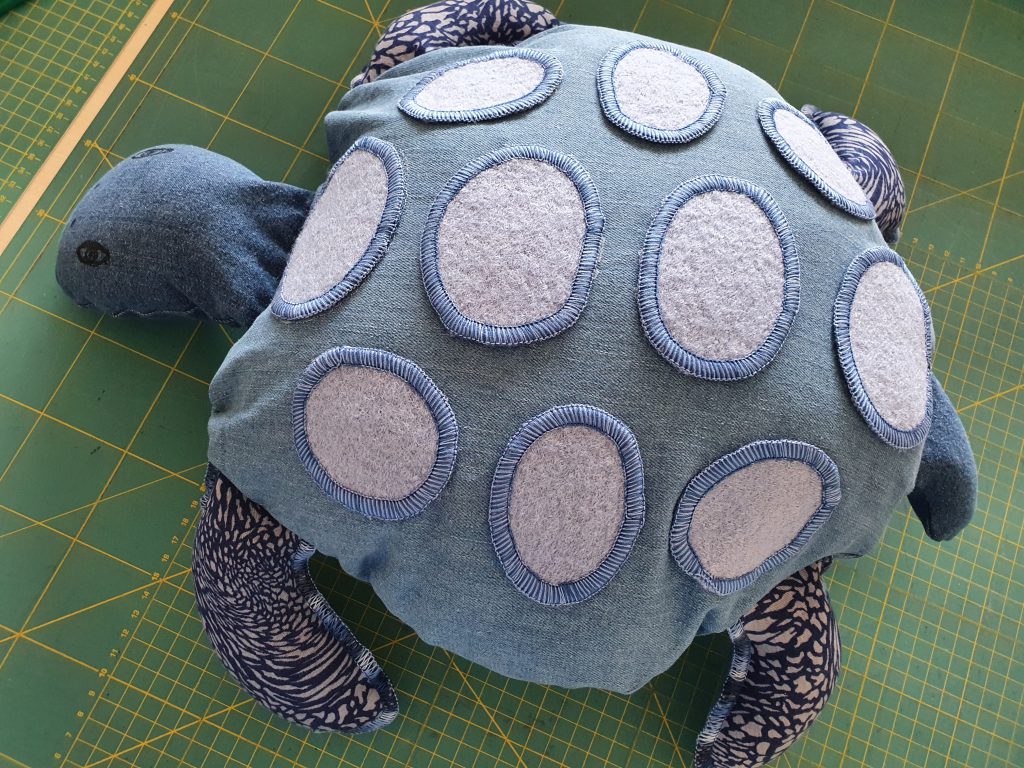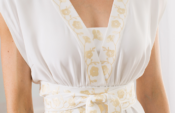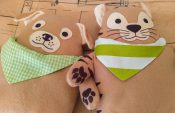Perhaps you have already come across our new overlock feet via Youtube? With the feet #L23 and #C23 curves and small circles can be sewn easily, precisely and quickly with overlock, chain or cover stitch. During developing the curve feet for the overlocker and combo machines, we thought about how to show the advantages of these feet briefly with a project. The result are two cuddly and decorative turtles. In two posts I will show you how you can sew these pillows. Today we start with the blue turtle. In the post below you will find the instructions and the free pattern for it.
Sewing a pillow in the shape of a turtle – Instructions

My decision for the turtle was driven by memories of vacations, may it be the sudden appearance of sea turtles or the visit at the giant turtle nature reserve. This is my result after a few sketches:
The blue turtle is my project for the L23. Its focus lies on overlock stitches. But of course, you can also sew it with the C23 on your L 890.
For the green turtle refer to the separate instructions, designated to C23 and the L 890. Today you get the tutorial for the blue turtle. How you can sew the green pillow, I’ll show you next week.
Free pattern for the turtle pillow
The pattern for both projects is nearly the same. This link allows the free pattern download for the blue turtle:
Download pattern (PDF, DIN A4)
Instructions
This project is ideal to use up fabric pieces. In my cupboard I find boxes of blue materials.
For the body I found enough medium weight stretch denim. For the head and the tail I used some heavier denim. The feet are made from faux fur knit with print on the knit side plus denim on the underside of the feet. Boiled wool felt was my choice for the dots. These are only proposals; you sure find something suitable in comparable quality in your stash.
List of materials:
- L 850 or L 860 (or L 890)
- L23 (or C23)
- Sewing machine with straight stitch/zigzag
- Fabric for body, 40 x 90 cm / 16 x 35″
- Fabric for head and tail, 20 x 40 cm / 8 x 16″
- Fabric for Feet, 20 x 80 cm / 8 x 32″ (or 20 x 40 cm / 8 x 16″ in two different qualities)
- Fabric for the dots, 20 x 35 cm / 8 x 14″
- Zipper (by the yard), 32 cm / 12 1/2″
- Stuffing
- Fabric color pen or buttons for the eyes (optional)
- Overlocker/Serger thread
- Decorative thread, for example Madeira Cotona or Mettler Silk Finish Cotton 28 or 40. Sulky 12wt is another option.
If you only have fine threads, you can use two or three threads in upper/lower looper to build up body by mixing your own thread. That was my procedure with the feet, using Silk Finish Cotton 50 with Lana and fine Cotona. A texturized thread can also be used. Try what you have!
Cutting
- Body, twice at the fold (pattern includes 1 cm / 3/8″ seam allowance).
- Head and Tail, Fabric right sides together, once the Head and once the tail (pattern includes 6 mm / 1/4″ seam allowance).
- Feet, fabric wrong sides together, twice the front feet, twice the rear feet (= 4 pieces each).
- Dots, large dot, cut 4 pieces, small dot cut 6 pieces.
- Zipper end parts. 4 x 10 cm / 1 1/2 x 4″, cut 4 pieces from the reminder of the body or head.
- Cut the lower body at the fold into two pieces, that is where the zipper will be added. The width of the zipper defines the seam allowance at this seam line.
Processing, zipper preparation
On the zipper, add two pieces of fabric on each end, one on the right, one on the wrong side. Stitch across (with the sewing machine).
If you do not have a sewing machine, just lay the pieces on top and bottom of the zipper and clip them on, they will be secured in place by sewing the zipper in.
For this procedure of adding a zipper tab, there are numerous articles available. A detailed description for example is in the blog of Jen Belnap.
Body decoration
Attach the curve foot L23 (C23).
Thread the overlocker/serger with 3-thread overlock wide (stitch 3). Thread the upper looper with decorative thread. Set the stitch length between 2 and 2.5. Deactivate the knife. Testsew on some spare fabric of the dots, fine-tune where necessary.
Neaten the dots with the wide 3-thread overlock.
For tips on how to do this, please refer to our video tutorial on the curve feet L23 and C23:
We also show how to end the stitch in a circle and you will find more tips on the use of the curve feet.
Don’t forget to press each seam. For me it is a standard procedure, so I will not mention it after each seam.
Sewing the feet
Thread the lower looper with decorative thread. Testsew on some spare fabric of the feet, finetune where necessary.
Having the feet wrong sides facing, stitch around the curves, leaving the joint to the body open for stuffing.
The procedure of sewing the curves is the same as sewing the circles of the dots.
Stuff the feet softly.
Sewing head and tail
Thread the Maschine with 4-thread overlock, Stitch 1, overlocker/serger thread in needles and loopers.
Next is stitching the head. In case you want eyes, buttons or other decoration, now is the moment to add that.
Turtles have narrow eyes, first I was drawing them, but was then not really satisfied with the result, and have finally changed the head of my turtle to a neutral version.
Stitch the head right sides facing, leaving the joint to the body open (deactivate the knife, there is no seam allowance to be cut).
Turn the head, right side out, stuff softly.
Stitch the tail, right sides facing, leaving the joint to the body open (follow the same procedure as with the head).
Turn the tail, right side out, stuff softly.
Sewing in the zipper
Next step is sewing in the zipper.
Optionally, attach Standard Overlock Foot #L10 (with Tape Guide). Although, for the sake of ease, I used the curve foot for the zipper.
Place the zipper right on right onto the cut of the lower body and stitch together.
Putting the turtle together
Place the head right on right at the front (1) of the lower body.
Place the tail right on right at the rear (6) of the lower body.
Pin/clip the rear legs (4/5) right sides facing on the lower body.
Pin/clip the front legs (2/3) right sides facing on the lower body.
Thread the machine with 3-thread overlock narrow (stitch 4).
Stitch once around the lower body to baste the parts in place.
Open the zipper.
Apply the dots
Thread the machine with 4-thread overlock (stitch 1).
Place the dots on the upper body. Here I have placed the upper body onto the lower body to picture what the result will look like.
Stitch the dots in place with the sewing machine, or by hand, if you don’t have a sewing machine. If you have an L 890, using a 2-thread chainstitch is an alternative.
Sewing the turtle together
Place the upper body right sides facing onto the lower body and pin/clip. Cut back any size difference caused by the zipper. Make sure the zipper is open.
Stitch around the body considering the seam allowance of 1 cm / 3/8″.
Tip: the OL/CS Height Compensating Tools may be helpful stitching over the thick parts. Find here the video tutorial for the Height Compensating Tools:
Turn the turtle, right side out.
Stuff the turtle and close the zipper.
Tip: if you use the turtle as a toy and it needs washing, I recommend using the body pattern to sew a stuffing pillow for inside. I used a soft cotton fabric.
I think this was it – sewing was fun, and I hope you enjoy it too. Do not hesitate to share your project pictures with us!
The instructions for the green turtle will follow soon! If you want to continue working with the curved feet in the meantime, here are two ideas:
Makeup removal pads are suitable as a simple starter and practic project. Don’t hesitate to use these new curve feet for such projects.
… and here the picture of a project from Mary Beck, Educator and Serger Specialist at BoA:
The instructions for this tic-tac-toe game, in which our curved feet can show their full strength, will be published later this year on the US blog Weallsew. But maybe the photographic inspiration is enough for you to create your own game board?
Have fun using the new curve feet for the BERNINA L8 series!
Doris

 BERNINA Corporate Blog -
BERNINA Corporate Blog -






































They look very cute!